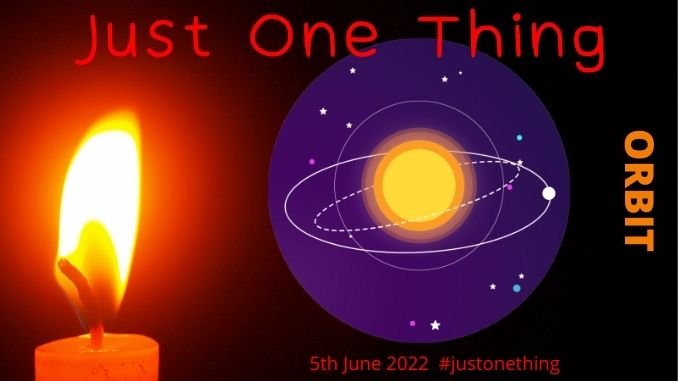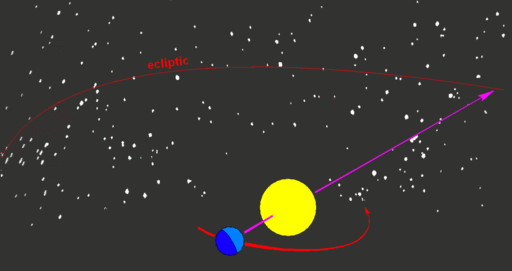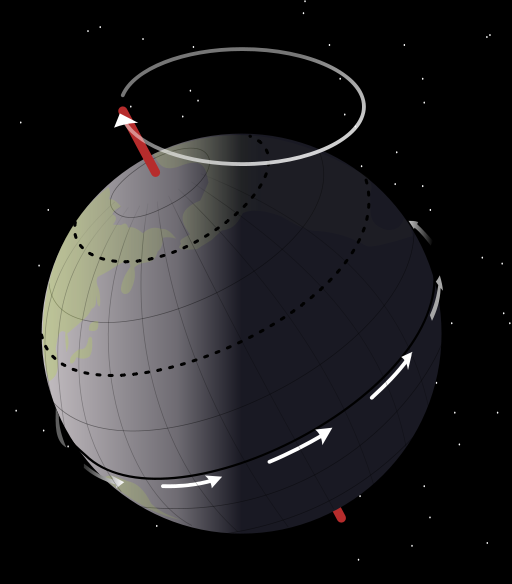Imagine that as we orbit the sun we could, as it were, look through the sun and see what was on the other side.
What would we see?
We would see whatever constellation that the sun is “in” at that point in our orbit.
The constellation that the sun is “in” is always the one directly opposite “us” as we orbit the sun, but of course we cannot see it because of the blinding light of Apollo.
Think Of A Ball-Headed Skewer
Another way to imagine it is to think of a “ball headed bamboo skewer,” that is, a skewer with a sharp point at one end for skewering stuff and a green ball at the other end for you to hold while chomping down on the skewered morsel.
Let us suppose the skewered morsel to be a meatball.
Now imagine that the green ball is the earth, and the meatball is the sun. Without making a mess, gently hold the meatball between your index finger and your thumb and tap or push the green ball so that it begins to orbit the said meatball. As it does so, the pointy end of the skewer will rotate too, if you are lucky.
The pointy end of the skewer represents the “ecliptic,” that is, the path the sun appears to take across the constellations when viewed from the earth.
The Ecliptic
Your Sign May Not Be Your Sign
So when somebody asks you what your star sign is and you tell them it’s “Libra,” what you are telling them is that when you were born on the green ball, the skewer went through the meatball and pointed at the constellation of the scales. Right?
Well, I don’t want to knock you off kilter, but you were NOT born when the sun was in Libra if you think you were, for two reasons.
Constellation Sizes Vary
Firstly, in western, or “tropical” astrology, the star signs are each given an equal number of degrees on the ecliptic: 12 signs / 360 degrees = 30 degrees each.
However, the actual constellations in the sky all vary in size as you would expect. That means the sun does not spend an equal amount of time “in” each constellation.
The sidereal sun spends a month and a half in Virgo, but just a couple of weeks in Scorpio, for example.
Axial Precession
Secondly, as the earth orbits the sun, the axis of the earth also rotates very slowly in a process known as “axial precession.” It is rather like the way the axis of a spinning top gradually moves round while the top itself is spinning.
Axial precession causes the earth’s relation to the sun to change very gradually, and the spring equinox to begin ever so slightly later each year. Each cycle lasts 26,000 years. Once every couple of thousand of years or so, the spring equinox begins in a different constellation.
Tropical Astrology vs the Sidereal Sun
According to traditional “tropical astrology,” which ignores both the different sizes of the constellations and the gradual changes of axial precession, the “sun” is “in” Aries the Ram from the beginning of spring, approximately from 21st March, until April 19th.
Well, that used to be true, way back in Geoffrey Chaucer’s day, for example, when the pilgrims set off on their pilgrimage to Canterbury in early April, when,
“… the yonge sonne
Hath in the Ram his halve cours yronne…”
However, this year of grace, 2022, the sidereal sun did not enter Aries until around 21st April or depart it until 12th May.
Out Of Kilter Libran, Or Stressed Out Virgoan?
And so, my dear Libran, just because you were born sometime between 23rd September and 23rd October, does not mean that you were born when the sun was “in” Libra since nowadays the sun does not enter Libra until the end of October.
And if my pointing that out to you causes you some pain and anguish, is that not further evidence that you are not the well-balanced Libran you thought you were, but more like a stressed out Virgo in whose sign the sun was sojourning when you leapt into this dangerous world?
David Hurley
This post was originally published on the #JustOneThing community page on the Hive blockchain.
Sources:
https://en.wikipedia.org/wiki/Axial_precession
https://en.wikipedia.org/wiki/Ecliptic
https://masteringthezodiac.com/what-is-my-sidereal-sign/
https://www.canva.com/





Recent Comments